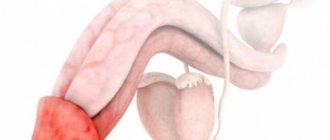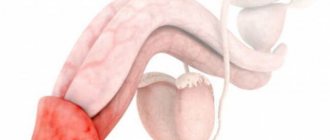Like other parts of the body, there are sebaceous glands called Tyson glands on the head of the penis and the inside of the foreskin.
They produce a thick secretion - spegma - the purpose of which is to protect the penis from friction against the foreskin or other damage. Normally, this lubricant has a milky color, but some physiological reasons or pathological processes can provoke a change in its consistency and the formation of a white coating on the head of the penis.
Attempting to cope with this problem on your own is dangerous and can lead to the development of serious complications. Therefore, if this symptom occurs, you should immediately seek the help of a urologist.
Mycosis of the penis
The content of the article
Mycosis of the penis, also called candidiasis or thrush, is an inflammatory disease of an infectious nature, most often caused by Candida albicans. This disease is often overlooked (due to the possible lack of symptoms, ignorance of the problem, or the shame that accompanies the disease), but you should know that if left untreated, it can lead to health problems in the long term, such as:
- yeast inflammation of the glans and foreskin;
- erectile disfunction;
- infertility;
- tumors.
Infertility
What are the causes of mycosis of the penis? How to detect it? How to recognize the disease? Which doctor should you contact for help? What drugs should be used in therapy and how to dose them?
Where does penile mycosis occur?
Genital mycoses usually develop in the female genital tract. In men, infection most often occurs through sexual contact. You can also become infected with the yeast Candida albicans from a towel, toilet, swimming pool or sauna. In the male body, mycosis of the penis rarely develops independently, although such situations also occur.
Factors contributing to this include:
- taking certain medications, especially antibiotics and steroids;
- neglect of hygiene of intimate places - too infrequent or careless washing;
- anatomical problems, especially phimosis, preventing free access to the glans penis;
- inaccurate drying of the penis after swimming, before getting dressed;
- use of wet towels;
- wearing thick, windproof clothing and underwear made of synthetic materials.
Remember that the ideal conditions for yeast development are a combination of heat and moisture. It is also easier for people with weakened immune systems (such as HIV-infected people) and diabetics to develop infections.
Symptoms of mycosis of the penis
Candidiasis in men can be difficult to detect. It is estimated that there are no symptoms of penile mycosis in approximately 20% of cases. This results in the disease remaining undetected in the body, which leads to infection of other people, as well as the development of other infections in the partially connected urinary and reproductive tract. In the remaining 80% of cases, penile candidiasis has symptoms such as:
- itching of the penis;
- rash on the penis (red spots);
- pain in the penis during urination and ejaculation;
- white coating, sometimes with spots;
- strong unpleasant odor;
- bubbles from which blood and purulent contents come out;
- redness of the penis;
- difficulty retracting the foreskin that is stuck to the head of the penis.
Itching of the penis
Systemic and flu-like symptoms may occur, such as fever, chills, or pain in the joints and muscles.
Causes of white plaque
The causes of white plaque on the penis are classified into three groups:
- physiological. Associated with the peculiarities of the secretion of tyson glands located under the foreskin. The problem is aggravated by the lack of proper hygienic care of the genitals;
- non-infectious (endogenous). Caused by disruption of internal organs. Whitish accumulations on the penis are a concomitant symptom of chronic diseases or a sign of activation of opportunistic microorganisms that are part of the natural microflora of the body;
- infectious (exogenous). These are sexually transmitted diseases (STDs).
In the first case, it is enough for a man to get medical advice. To eliminate other causes, proper treatment is required.
Which doctor should I see if I have an itchy penis?
Itching of the penis, red spots on the penis and other symptoms of this type may indicate the development of candidiasis. However, it is also possible that these are symptoms of a viral or bacterial infection or one of the sexually transmitted diseases such as gonorrhea or chlamydia.
In particularly difficult diagnostic cases, a smear from the foreskin or urethra may be required. However, for an experienced physician, careful questioning of the patient regarding the symptoms experienced and the circumstances under which they occur is usually sufficient.
Diagnosis and treatment
Treatment of diseases of the male reproductive system, including treatment of STDs, is the responsibility of urologists and andrologists. In case of an infectious lesion, therapy is prescribed by a venereologist. The cause of plaque on the penis is diagnosed based on the results:
- visual medical examination;
- studying the patient's premorbid background;
- laboratory tests: OCA and blood biochemistry, urethral smear, urine test;
- ultrasound examination of the pelvic organs.
Based on the results of the examination, the doctor chooses treatment tactics, determines medications, dosage and duration of the therapeutic course. For bacterial, prokaryotic, and parasitic infections, antibiotics are prescribed. Candidiasis is treated with antimycotics in tablets and ointments. For diabetes and psoriasis, basic treatment and diet therapy are adjusted.
Preventive measures help prevent unpleasant manifestations - careful genital hygiene, barrier contraception, strengthening the immune system and following the recommendations of the attending physician (for chronic diseases).
An important point is a timely visit to a urologist, both in the event of symptomatic complaints and for prevention. Make an appointment
How to treat red spots on the head of the penis?
How to treat red spots on the head of the penis and other symptoms of the disease? The first and most important rule is do not self-medicate. Incorrect therapy can spread and intensify the symptoms of the disease. It should be remembered that there are completely professional medications that can cure mycosis in a relatively short time and prevent its recurrence.
These include:
- Clotrimazole is a drug that acts by inhibiting the synthesis of ergosterol, a chemical compound involved in the construction of the cell membrane of the fungus;
- Fluconazole is a synthetic drug, a triazole derivative, with a mechanism of action similar to clotrimazole, but taken systemically, in tablet form.
Clotrimazole
In addition, for preventive purposes, it is necessary to remember such recommendations as:
- maintaining personal hygiene;
- If possible, avoid using toilets in public places;
- using condoms during sexual activity;
- supplementing the menu with a large portion of vegetables.
Plaque under the foreskin as a sign of the development of various pathologies
Failure to comply with basic personal hygiene standards can lead to the appearance of plaque. Formation on the surface is very often a process of biological processes that favorably influence the proliferation of pathogens. The secretion of smegma, is a natural lubrication of the head, consists of fats, which provide a good basis for the appearance of microbes, fungi, and bacteria.
If, along with the plaque, problems with urination, inflammation of the prepuce, and pain occur, then this signals the need to contact a qualified specialist and get medical help.
Plaque is a symptom of the following diseases:
- candidiasis;
- posts;
- balanitis;
- phimosis;
- gonorrhea;
- chlamydia;
- genital herpes.
The sign also indicates diseases such as syphilis, dermatitis, diabetes, lichen sclerosus. Plaque can be an alarming signal about the development of oncology, penile cancer. Therefore, a timely visit to a therapist, venereologist, or urologist will help to catch the disease in the early stages, which will maximize the chances of a full recovery.
Symptoms and diseases of the foreskin:
- Swelling of the foreskin
- Foreskin rupture
- Inflammation of the foreskin
- Redness of the foreskin
- Foreskin removal
- Narrowing of the foreskin
- Ulcers on the foreskin
- Herpes on the foreskin
- Red spots on the foreskin
- Sores on the foreskin
- Dryness of the foreskin
How to use ointment for mycosis of the penis?
Ointment for mycosis of the penis is used for about 7 days. You need to rub the drug in several times a day, as recommended in the leaflet. Special hygiene should be observed, washing hands thoroughly before and after applying the ointment. If symptoms do not resolve within one week, systemic therapy may be required.
Especially in this case, it is important to read the dosage instructions carefully. Fluconazole is used for different types of mycoses in different doses and time intervals. To treat penile candidiasis, take only one tablet containing 150 mg of the active substance. Unlike vaginal yeast infections, maintenance doses are not used.
ONLINE REGISTRATION at the DIANA clinic
You can sign up by calling the toll-free phone number 8-800-707-15-60 or filling out the contact form. In this case, we will contact you ourselves.
How to treat
If the head is covered with a white coating, and a lot of cheesy lumps have accumulated under the foreskin, then the reason is poor hygiene. It's easy to get rid of excess smegma. To do this, just wash your penis with a delicate cleanser in the morning and evening. If the glans becomes red, you need to completely retract the foreskin 2-3 times a day and treat it with miramistine or chlorhexidine.
Pills
Table 1. Tablets to eliminate various causes of plaque on the head
| Pathology | Name of the drug |
| Candidiasis | Antifungal: Fluconazole, Flucostat. Polyene antibiotics: Nystatin, Pimafucin. |
| Chlamydia | Doxycycline, azithromycin. |
| Syphilis | Penicillin preparations: “Retarpen”, “Extencillin”, “Bicillin-1”, combined “Bicillin-3”, “Bicillin-5”. |
| Herpes | Acyclovir |
| Gonorrhea | "Ciprofloxacin", "Tsiprolet". |
For reactive inflammation of the head caused by urethritis, tablets are prescribed according to the results of a smear analysis.
Ointments
Ointments are prescribed in cases where plaque on the head is caused by an infection that has not yet penetrated the blood. External agents are also used as adjuvant therapy to relieve inflammation.
Table 2. Ointments prescribed to eliminate the causes of white plaque on the head
| Pathology | Ointment |
| Candidiasis | "Clotrimazole", "Itraconazole", "Pimafucin". Combined ointments: “Clomegel”, “Metrogil plus”. |
| Allergic dermatitis, inflammation | “La-Cri”, “Zinc ointment”, “Advantan”, “Hydrocortisone”, “Dex-gentamicin”. |
| Erythroplasia Keira | Cytostatics: 5% Imicvomide cream, 5% 5-fluorouracil cream, prospidine ointment. Combine with corticosteroid ointments: Lokoid, Advantan, Afloderm. |
| Lichen sclerosus | Steroid drugs, ointments with 0.1% tacrolimus. |
| Ulcerative lesions, peeling | "Solcoseryl" |
| Balanoposthitis | "Levomekol", tetracycline ointment. |
| Herpes | "Acyclovir", "Zovirax" |
Surgical intervention
Surgical intervention is used in cases where conservative therapy does not produce positive dynamics.
Table 3. Surgical methods to eliminate the causes of plaque on the glans
| Pathology | Type of intervention |
| Chronic candidiasis balanoposthitis against the background of diabetes mellitus and other systemic diseases, phimosis | Circumcision. The doctor excises the skin of the foreskin and stitches the remainder around the glans. |
| Penile cancer, Queyra's erythroplasia | Excision of the lesion with a laser (ablation) or burning out using the cryodestruction method + local therapy described above and intravenous infusion of bleomycin (chemotherapy). |
| Lichen sclerosus | Surgical intervention in the form of urethroplasty is used in cases where the lesion prevents urination. |
At home
Home recipes can only be used after visiting a doctor and with his permission.
For herpes, the head of the penis can be lubricated with aloe or Kalanchoe pinnate juice. It is applied to the head pre-treated with chlorhexidine 4-5 times a day.
For candidiasis, soda baths help get rid of the white film. The solution is prepared at the rate of a tablespoon of soda per liter of warm water. The procedure is carried out at night for a week. The penis is dipped for 2-3 minutes, then removed, dried and antifungal ointment is applied.
Preparation of soda solution
A good remedy for intermediate treatments, including for lichen, are baths with infusions of chamomile, oak bark, sage, and calendula. Recipe: pour a tablespoon of raw material into a glass of boiling water, leave until the temperature drops to 30˚C. The penis should be kept in the bath for 10-15 minutes, while it is important to move the foreskin away from the head. Repeat the procedures 2-3 times a day.
Nutrition
For any type of inflammation of the head of the penis, spicy, smoked, salty foods, and alcohol should be excluded from the menu. Compliance with a diet is also required for candidiasis.
Diet for candidiasis







